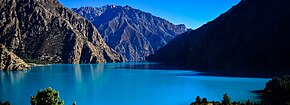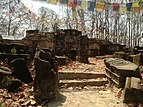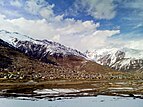Karnali Province
Karnali Province
कर्णाली प्रदेश Karnali Pradesh | |
|---|---|
From top going clockwise:Phoksundo lake,Sinja Valley,Simikot,Rara lake,ruins of Kakre Bihar inSurkhetandKanjiroba | |
 Location of Karnali Province | |
Divisions of Karnali Province | |
| Coordinates:29°16′N82°11′E/ 29.27°N 82.18°E | |
| Country | |
| Formation | 20 September 2015 |
| Capital | Birendranagar |
| Largest city | Birendranagar |
| Districts | 10 |
| Government | |
| • Type | Province |
| • Body | Government of Karnali Province |
| •Governor | Tilak Pariyar |
| •Chief Minister | Jeevan Bahadur Shahi(NC) |
| • High Court | Surkhet High Court |
| •Provincial Assembly | Unicameral(40 seats) |
| •Parliamentary constituency | Pratinidhi Sabha12 Rastriya Sabha8 |
| Area | |
| • Total | 27,984 km2(10,805 sq mi) |
| • Rank | 1st |
| Population (2021) | |
| • Total | 1,694,889 |
| • Rank | 7th |
| • Density | 61/km2(160/sq mi) |
| • Rank | 7th |
| Demonym | Madhya PashchimeliNepali |
| Time zone | UTC+5:45(NST) |
| Geocode | NP-SI |
| ISO 3166 code | NP-P6 |
| Official Language | Nepali |
| Other Official Languages | 1.Khas-Jumli 2.Magar |
| HDI | 0.469 (low) |
| HDI rank | 7th |
| Literacy | 62.77% |
| Sex ratio | 95.78♂/100♀(2011) |
| GDP | US$1.44 billion |
| GDP rank | 7th |
| Website | www.karnali.gov.np |
Karnali Province(Nepali:कर्णाली प्रदेश) is one of the sevenfederal provincesofNepalformed by thenew constitution,which was adopted on 20 September 2015.[1]The total area of the province is 27,984 square kilometres (10,805 sq mi), making it the largest province in Nepal with 18.97% of the country's area. According to the2011 Nepal census,the population of the province was 1,570,418, making it the least populous province in Nepal. The province borders theTibet Autonomous RegionofChinato the north,Gandaki Provinceto the east,Sudurpashchim Provinceto the west, andLumbini Provinceto the south.[2]Birendranagarwith a population of 154,886 is both the province's capital andlargest city.[3]
Etymology
[edit]The province's name is derived from theKarnali River,which flows through the province. A meeting of theprovincial assemblyon 25 February 2018 adopted the name Karnali for the province.[4][5]
History
[edit]Karnali is an old civilization connected with theKarnali River[6]Archaeological sites found inJumla,SurkhetandDailekhinfer that the area was part of the oldKhasa kingdom,established during the 11th century. The capital of the Khas Kingdom wasSinjain present-dayJumladistrict. The kingdom expanded to a great extent in the 13th and 14th century; expanding toGarhwalin the west,Mansarowarand Guge regions of Tibet in the north,Gorkha-Nuwakotregions in the east andKapilvastuwith large areas ofTeraiin the south. After the late 14th century, the Khas empire collapsed and was divided into theBaise Rajya(22 principalities) inKarnali-Bheriregion.[7]
Before theunification of modern Nepal,a part of Karnali (fromKarnali RivertoBheri River) was in theSanghiya Baise Rajya(22 principality confederacy). The principalities were sovereign but intermittently allied among themselves until they were annexed during the unification of modern Nepal from 1744 to 1810.
Geography
[edit]Karnali is the largest province ofNepalwith an area of 27,984 km2(10,805 sq mi). The province is surrounded byGandaki Provincein east,Lumbini Provincein south-east and south,Sudurpashchim Provincein the west andTibet Autonomous RegionofChinain north.
The province has occupied higher mountains land of north and mid-hills ofNepal.It containsKubi Gangri,ChanglaandKanjirobamountains in north. TheShey Phoksundo National ParkwithPhoksundo lakeis the largest national park of Nepal andRara lakeis the largest lake of Nepal which are located in Karnali Province.Karnali Riveris the biggest river of the province which is thought to be the longest river in Nepal.Seti RiverandBheri Riverare tributaries of Karnali, andKupinde Dahais a lake of Karnali.
| Location | August
(°F) |
August
(°C) |
January
(°F) |
January
(°C) |
Annual
Precipitation (mm/in) |
|---|---|---|---|---|---|
| Kharpunath | 48 | 8.9 | 9.5 | −12.5 | 209.5/8.2 |
| Simikot | 54.9 | 12.7 | 17.6 | −8 | 304.2/12 |
| Chandannath | 60.8 | 16 | 29.7 | −1.3 | 728.9/28.7 |
| Narayan | 71.8 | 22.1 | 45.3 | 7.4 | 1252.3/49.3 |
| Birendranagar | 78.4 | 25.8 | 53.2 | 11.8 | 1651/65 |
Demographics
[edit]According to the 2021 Census of Nepal, Karnali Province has a population of 1,688,412 comprising 864,651 females and 823,761 males. The province has the lowest population in the country, having 5.93% of the population on 19.74% of the land. The population density of the province is 56 people per square kilometer.[9]
Ethnic groups
[edit]| Community | Population | Percentage |
|---|---|---|
| Chhetri | 653,379 | 41.61% |
| Kami | 248,761 | 15.84% |
| Magar | 170,797 | 10.88% |
| Thakuri | 161,556 | 10.29% |
| Hill Brahmin | 131,288 | 8.36% |
| Damai | 62,464 | 3.98% |
| Sarki | 41,230 | 2.63% |
| Sanyasi | 26,513 | 1.69% |
Khas Arya is the largestethno-linguisticindigenous group in the province, with Chhetri, Kami, Thakuri and Bahun dominating the population. The largest non-Khas Arya group are theMagarswho make up 170,797 (10.88%) of the population.Tamang(0.88%) andGurung(0.70%) are other Janajati groups in the province with a significant population.[9][10]
Languages
[edit]| Language | Speakers | Percentage |
|---|---|---|
| Nepali | 1,500,538 | 95.55% |
| Magar | 32,537 | 2.07% |
| Tamang | 11,252 | 0.72% |
| Tharu | 6,443 | 0.41% |
| Others | 19,648 | 1.25% |
Of the population, 95.55% in the province speakNepalias their native language. Other languages spoken in the region areMagar(2.07%) andTamang(0.72%).[9][10]
TheLanguage Commission of Nepalhas recommendedMagaras an additional official language in the province. The most spoken language isNepali,which is known with its original nameKhas Bhashain the province.[11]
Religion
[edit]Hinduismis the most followed religion in the province with 95.34% of the people identifying as Hindus.Buddhismis the largest minority religion, being followed by 3.09%, andChristianityis the second-largest minority religion, being followed by 1.30% of the population.[10]
Government and administration
[edit]The Governor acts as the head of the province while the Chief Minister is the head of the provincial government. The Chief Judge of the Surkhet High Court is the head of the judiciary.[12]The present Governor, Chief Minister and Chief Judge are Govindra Prasad Kaulani,Jeevan Bahadur Shahiand Hari Kumar Pokharel respectively.[13][14]The province has 40provincial assembly constituencies,12House of Representative constituenciesand eightNational Assemblyseats.[15]
Karnali has aunicamerallegislature, like all of the other provinces in Nepal. The term length of the provincial assembly is five years. TheProvincial Assembly of Karnali Provinceis temporarily housed at the Irrigation Division Office inBirendranagar.[16]
Administrative subdivisions
[edit]Karnali is divided into ten districts.
| Districts | Headquarters | Population (2011)[17] |
|---|---|---|
| Western Rukum District | Musikot | 155,383 |
| Salyan District | Salyan | 242,444 |
| Dolpa District | Dunai | 36,700 |
| Humla District | Simikot | 50,858 |
| Jumla District | Chandannath | 108,921 |
| Kalikot District | Manma | 136,948 |
| Mugu District | Gamgadhi | 55,286 |
| Surkhet District | Birendranagar | 350,804 |
| Dailekh District | Narayan | 261,770 |
| Jajarkot District | Khalanga | 171,304 |
A district is administered by the head of theDistrict Coordination Committeeand the District Administration Officer. The districts are further dived to municipalities or rural municipalities which are further divided into wards. There are 25 municipalities and 54 rural municipalities in the province.[18]The capital and largest city of the province isBirendranagar.It is only city in the province with a population of over 50,000.
| Rank | District | Pop. | |||||||
|---|---|---|---|---|---|---|---|---|---|
 Birendranagar |
1 | Birendranagar | Surkhet | 100,458 | |||||
| 2 | Gurbhakot | Surkhet | 43,765 | ||||||
| 3 | Dullu | Dailekh | 41,540 | ||||||
| 4 | Bheriganga | Surkhet | 41,407 | ||||||
| 5 | Bangad Kupinde | Salyan | 36,052 | ||||||
| 6 | Chhedagad | Jajarkot | 35,295 | ||||||
| 7 | Bagchaur | Salyan | 34,118 | ||||||
| 8 | Shaarada | Salyan | 33,730 | ||||||
| 9 | Aathbiskot | Rukum West | 33,601 | ||||||
| 10 | Bheri | Jajarkot | 33,515 | ||||||
Economy
[edit]Karnali Province has the lowest growth rate in the country with an annual economic growth rate of 5.7% and is also contributes the least to the GDP at 4.1%. The province is among the poorest in Nepal with an estimated 28.9% of people living under absolute poverty (second highest in the country) and 51.7% of the people aremultidimensionally poor(highest in the country). The unemployment rate in the province stands at 9.7% which is the third-lowest in the country.[19]
Agriculture
[edit]Karnali is the largest producer of barley in the country and accounted for 43% of the country's total share of barley production in 2018/19.[19]
Environment
[edit]It is estimated in 2023, or the year 2078 in Nepal, that more than 96 percent or 1,644,022 of the citizens of Karnali province are forced to drinkcontaminated water,and only 3 percent or 50,847 of citizens in the province have access to cleandrinking water,according to Nepalnews.[20]
See also
[edit]References
[edit]- ^"Nepal Provinces".statoids.com.Archivedfrom the original on 2017-07-18.Retrieved2016-03-21.
- ^"Prov 6 named as Karnali, permanent capital in Birendranagar".www.myrepublica.com.24 February 2018.Archivedfrom the original on 25 February 2018.Retrieved24 February2018.
- ^"Government finalises provinces' governors and temporary headquarters".nepalekhabar.com.17 January 2018.Archivedfrom the original on 15 November 2020.Retrieved19 January2018.
- ^"Province 6 named Karnali; Surkhet capital".kathmandupost.ekantipur.com.Archivedfrom the original on 2019-02-02.Retrieved2019-03-07.
- ^Times, Nepali (13 July 2018)."Naming new provinces".Archivedfrom the original on 2018-09-17.Retrieved2019-03-07.
- ^"कर्णाली प्रदेश एक चिनारी".www.ocmcm.karnali.gov.np.The office of chief minister and cabinet of Karnali Province.Archivedfrom the original on 9 July 2018.Retrieved9 July2018.
- ^"Nepal in the Medieval Period".www.telegraphnepal.com.2 February 2015. Archived fromthe originalon 26 February 2018.Retrieved26 February2018.
- ^"Nepal Travel Weather Averages (Weatherbase)".Weatherbase.Archivedfrom the original on 2020-09-30.Retrieved2018-04-28.
- ^abc"तथ्याङ्कमा कर्णाली प्रदेश.pdf".Google Docs(in Nepali). Central Bureau of Statistics, Nepal. p. 34.Archivedfrom the original on 2023-04-25.Retrieved2020-12-24.
- ^abc"National Data Portal-Nepal".nationaldata.gov.np.Archivedfrom the original on 2020-02-16.Retrieved2020-12-24.
- ^"सरकारी कामकाजको भाषाका आधारहरूको निर्धारण तथा भाषासम्बन्धी सिफारिसहरू (पञ्चवर्षीय प्रतिवेदन- साराांश) २०७८"(PDF).Language Commission.Archived fromthe original(PDF)on 6 September 2021.Retrieved28 October2021.
- ^"High Courts get their chief judges".Archivedfrom the original on 2018-03-23.Retrieved2018-04-27.
- ^"Mahendra Bahadur Shahi set to be Province 6 CM | Setopati – Nepal's Digital Newspaper".setopati.net.Archivedfrom the original on 2018-04-28.Retrieved2018-04-28.
- ^"President administers oath of office to newly-appointed governors".The Himalayan Times.2019-11-05.Archivedfrom the original on 2019-12-19.Retrieved2019-12-19.
- ^"CDC creates 495 constituencies".The Himalayan Times.2017-08-31.Archivedfrom the original on 2018-04-25.Retrieved2018-04-27.
- ^"First Provincial Assembly meeting begins in 4 provinces".Archivedfrom the original on 2018-04-28.Retrieved2018-04-27.
- ^2011 Census District Level Detail ReportArchived2018-09-02 at theWayback Machine,Central Bureau of Statistics.
- ^"स्थानिय तह".103.69.124.141.Archived fromthe originalon 2018-08-31.Retrieved2018-04-27.
- ^abKhatiwada, Dr. Yuba Raj. "Economic survey 2018/19, Government of Nepal, Ministry of Finance".Government of Nepal, Ministry of Finance:14.
- ^Samiti, Rastriya Samachar (2023)."96% drinking contaminated water".nepalnews.com.Archivedfrom the original on 2023-03-25.Retrieved2023-03-25.








